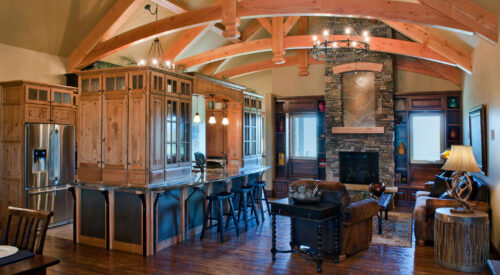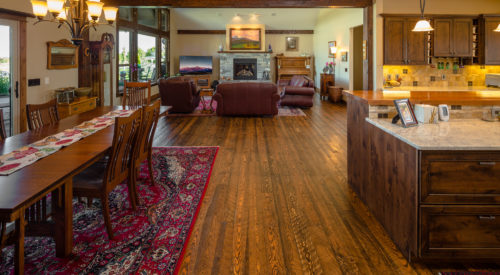Elkhorn Water Tank Retoration
Jan 31, 2018
BRINGING 3 GENERATIONS TOGETHER
Bruce Bell, representing the non-profit, Friends of the Elkhorn Water Tank, approached Steve Marks, owner of Marks Lumber, about assisting in the restoration of a 130-year-old railroad water tank located in a ghost town in the southwestern part of Montana, specifically, Elkhorn, MT.
Steve solicited the help of his son Cody Marks who manages the timber frame business at Marks Lumber and his father Bob Marks. Cody and teammate, Seth Slocum, have designed and built a variety of timber frame structures for homeowners, but never worked on such a unique project as refurbishing a historical water tank. They saw it as a challenge and as you read further, they will share some of those unique challenges faced when working on this historical project.
Marks Lumber project goals included –
- Rebuild the water tank walls in a way that would allow original water tank staves (vertical wooden planks) to be reused
- Replace the entire cone roof, spire, soffit, facia and shingles
- Replace 13 steel bands that wrap the staves
Cody and Seth began the restoration process at the computer. They took engineered CAD drawings and re-designed them to Shop drawings. This allowed them to build curved water tank walls in small sections in the Shop and then transport them to the job site. CAD software was used to draw all aspects of the round water tank and design the cone roof. It provided angles, lengths and measurements before starting and ensured that once onsite, in the middle of a ghost town, that everything fit together and went smoothly.
Original staves were bolted to wall sections and then installed one at a time with a forklift onto the original water tower platform.
All rafters and tapered soffit pieces were built at the Shop then hauled on site.
The cone shaped roof with 43 rafters all coming into a single king post was built onsite. 1x6 facia boards were curved around rafters to make a perfectly round facia.
Next, tapered soffit pieces were installed followed by a sheathed roof and then covered with synthetic underlayment.
Bob Marks constructed a new spire (copied from the original) on his lathe and it was installed on the roof.
The cone shaped roof was covered with cedar shingles. At this point wet weather conditions set in and restoration efforts were stopped.
Challenges discovered along the way -
- Brainstorming the process to find the safest, most efficient way to complete the job. CAD software aided in this.
- Because the peak of the roof was 30’ off the ground, everything was a challenge and safety was a priority.
- Originally, the roof was designed to be a hexagon, but Cody and Seth re-designed it to a cone in order to get a round facia to match the cylindrical building; an authentic replica of the original.
- Part way through, it was discovered that water tanks originally were designed to taper smaller on top and bigger on the bottom. The reason for this is to allow the metal bands not to fall off if things shifted. If the bands slipped down, they would tighten up, thus keeping the staves tight so the tower would not leak.
Yet to be completed in 2018 and probably the most challenging is installation of the 13 bands that wrap the staves. Each band is 70’ long, made of steel and needs to be wrapped around the walls 14’ to 28’ off the ground.
All Marks Lumber team members involved in the restoration enjoyed the opportunity to work on a project that was definitely outside the scope of a typical timber frame job. Having the opportunity to restore a part of history so others can enjoy it in the future was an honor. Cody commented that, “It was a challenge, but a lot of fun to design and build a cone shaped roof, something I may never get the chance to do again.”
Steve received the following testimonial from Bruce Bell, Friends of the Elkhorn Water Tank -
“Working with Steve, Cody and Seth from Marks Lumber is a big reason our project is nearing completion. The thing that separated them from others was their willingness to learn and attempt new things. Our project, a nearly 130-year-old railroad water tank, is very unusual. It meant learning and doing unusual things from start to finish. Marks Lumber workers not only accepted this challenge, they relished in every step of it from design to construction. And their fantastic work ethic is why our project is nearly done. We could not have done it without them.”
Click the following links to read newspaper articles featured in the Helena Independent Record and the Boulder Monitor regarding the restoration project.


Other Posts
Jan
2023

Five Timeless Interior Design Trends
When it comes to interior design, it may feel daunting to keep up with the ever-evolving trends that come with each passing season. Well, we're here t...
Jan
2023

Lumber Textures Defined
Lumber comes with the benefit of versatility. One of the simplest ways to create intrigue with lumber products is by using different textures. Circle ...
Dec
2022
Tips for Using Radiant Heating with Wood Floors
One of the best parts of living in Montana is experiencing all the seasons – and yes, we include wintertime. However, as much as we may love the...
